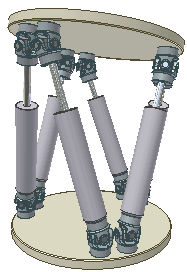Stewart platform


A Gough-Stewart platform is a type of parallel robot that has six prismatic actuators, commonly hydraulic jacks or electric actuators, attached in pairs to three positions on the platform's baseplate, crossing over to three mounting points on a top plate. Devices placed on the top plate can be moved in the six degrees of freedom in which it is possible for a freely-suspended body to move. These are the three linear movements x, y, z (lateral, longitudinal and vertical), and the three rotations pitch, roll, & yaw. The terms "six-axis" or "6-DoF" (Degrees of Freedom) platform are also used, also "synergistic" (see below).
Name of the device

Designed by Gough and Stewart
This specialised six-jack layout was first used by V E (Eric) Gough of the UK and was operational in 1954,[1] the design later being publicised in a 1965 paper by D Stewart to the UK Institution of Mechanical Engineers.[2] Although the short title Stewart Platform is now used for this jack layout, it would be fairer to Eric Gough to call it a Gough/Stewart platform. To be more precise, the original Stewart platform had a slightly different design.[3] See the more detailed references at the end of this article.
Synergistic
Because the motions are produced by a combination of movements of several of the jacks, such a device is sometimes called a synergistic motion platform, due to the synergy (mutual interaction) between the way that the jacks are programmed.
Hexapod
Because the device has six jacks, it is often also known as a hexapod (six legs). The trademarked name "hexapod" (by Geodetic Technology)[4] was originally for Stewart platforms used in machine tools. However, the term is now used for 6-jack platforms outside of the machine tool area, since it simply means "six legs".[5]
Applications
Stewart platforms have applications in flight simulators, machine tool technology, crane technology, underwater research, air-to-sea rescue, mechanical bulls, satellite dish positioning, telescopes and orthopedic surgery.
Flight simulation

The Stewart platform design is extensively used in flight simulation, particularly in the so-called full flight simulator for which all 6 degrees of freedom are required. This application was developed by Redifon, whose simulators featuring it became available for the Boeing 707, Douglas DC-8, Sud Aviation Caravelle, Canadair CL-44, Boeing 727, Comet, Vickers Viscount, Vickers Vanguard, Convair CV 990, Lockheed C-130 Hercules, Vickers VC10, and Fokker F-27 by 1962.[6]
In this role, the payload is a replica cockpit and a visual display system, normally of several channels, for showing the outside-world visual scene to the aircraft crew that are being trained. Payload weights in the case of a full flight simulator for a large transport aircraft can be up to about 15,000 kilogrammes.
Similar platforms are used in driving simulators, typically mounted on large x-y tables to simulate short term acceleration. Long term acceleration can be simulated by tilting the platform, and an active research area is how to mix the two.
RoboCrane
James S. Albus of the National Institute of Standards and Technology (NIST) developed the RoboCrane, where the platform hangs from six cables instead of being supported by six jacks.

LIDS
The Low impact docking system developed by NASA uses a Stewart platform to manipulate space vehicles during the docking process.
CAREN
The Computer Assisted Rehabilitation Environment developed by Motek Medical uses a Stewart platform coupled with virtual reality to do advanced biomechanical and clinical research.[7]
Taylor Spatial Frame
Dr. J. Charles Taylor utilized the Stewart platform to develop the Taylor Spatial Frame,[8] an external fixator used in orthopedic surgery for the correction of bone deformities and treatment of complex fractures.
Eric Gough - inventor of the 6-axis jack layout
Eric Gough was an automotive engineer and worked at Fort Dunlop, the Dunlop Tyres factory in Birmingham, England.[9] He developed his "Universal Tyre-Testing Machine" (also called the "Universal Rig") in the 1950s and his platform was operational by 1954.[1] The rig was able to mechanically test tyres under combined loads. Dr. Gough died in 1972 but his testing rig continued to be used up until the late 1980s when the factory was closed down and then demolished. His rig was saved and transported to the Science Museum (London) storage facility at Wroughton near Swindon.
See also
References
- 1 2 Gough, V. E. (1956–1957). "Contribution to discussion of papers on research in Automobile Stability, Control and Tyre performance". Proc. Auto Div. Inst. Mech. Eng.: 392–394.
- ↑ Stewart, D. (1965–1966). "A Platform with Six Degrees of Freedom". Proc. Institution of Mechanical Engineers (UK). 180 (Pt 1, No 15).
- ↑ Lazard, D.; Merlet, J. -P. (1994). "The (true) Stewart platform has 12 configurations". Proceedings of the 1994 IEEE International Conference on Robotics and Automation. p. 2160. doi:10.1109/ROBOT.1994.350969. ISBN 0-8186-5330-2.
- ↑ Parallel Robots - Second Edition by J.P. Merlet (pp. 48)
- ↑ Fraunhofer Research: Hexapod Robot for Spine Surgery
- ↑ http://www.flightglobal.com/pdfarchive/view/1962/1962%20-%201616.html
- ↑ http://www.motekforcelink.com/caren
- ↑ http://www.jcharlestaylor.com
- ↑ Tompkins, Eric (1981). The History of the Pneumatic Tyre. Dunlop. pp. 86, 91. ISBN 0-903214-14-8.
Further reading
- Bonev, I.A., "The True Origins of Parallel Robots", ParalleMIC online review
External links
| Wikimedia Commons has media related to Hexapods. |
- Pictures of the NIST/Ingersoll prototype octahedral hexapod
- Hexapod Structures for Surgery
- Hexapod for Astronomy